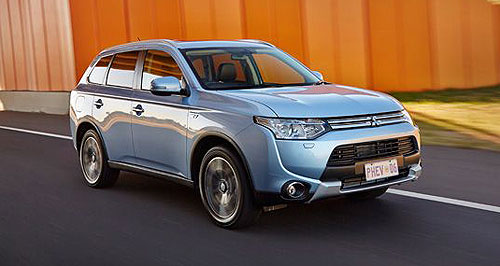Driven: Mitsubishi Outlander plug-in arrives
BY MIKE COSTELLO | 21st Mar 2014

At this pricing point, the Japanese-made PHEV not only undercuts the market’s only other plug-in hybrid vehicle — Holden’s smaller four-seat Volt ($59,990) — but also sits among a range of turbo-diesel SUVs including the Mazda CX-5 Akera ($49,240) and its Outlander DiD cousin ($46,890).
This is despite returning a remarkable ADR-approved combined-cycle fuel economy of 1.9 litres per 100km from its petrol-electric powertrain — easily the lowest of any SUV on sale. The carbon dioxide emissions are 44 grams per kilometre.
In addition, Mitsubishi will offer a better-equipped PHEV Aspire variant with a range of extra features and active safety technology from $52,490 — enough still to undercut the pre-launch projections of around $60,000-plus.
The PHEV arrives almost six months behind schedule due to global demand from countries such as the Netherlands, which has been incentivising the purchase of electric cars, chewing up allocation.
MMAL says the combination of the sharp pricing — it is cheaper than the tiny i-MiEV pure EV that remains on sale, technically — and Australia’s notable lack of government-funded incentives towards green motoring means each car is being sold on a tighter margin, according to MMAL executive director of marketing Tony Principe.
But the projected ‘halo’ effect such a car will have on Mitsubishi’s ageing range will be substantial, an expectation reflected in the heavy marketing spend being devoted to such a low-volume variant. The company will not talk sales figures, but says about one-third of its 203-strong dealer network will get the car, albeit in reduced numbers.
Unlike a regular hybrid vehicle such as Toyota’s Prius, the PHEV has a battery that can be recharged by either the engine or an external socket. The claimed pure electric range is 52km, and the car runs off batteries alone below 60km/h.
This means an atypical city commuter could spend a whole week using not one ounce of fuel.
The fuel tank capacity is 45 litres and it runs off 91 RON fuel. The theoretical driving range is therefore in excess of 900km.
The drivetrain consists of an 87kW/186Nm 2.0-litre petrol engine mounted at the front alongside a generator and one of two 60kW electric motors. At the rear axle is the second, torquier motor and a 300V and 12kWh lithium-ion battery pack. There is no mechanical link between the axles.
At speeds between 60km/h and 120km/h, the engine serves as a supplementary power source by feeding power into the system while charging the depleted battery cells. At speeds above 120km/h, it couples with the front axle and sends power there directly, complementing the rear electric drive.
There are also six levels of regenerative braking, controlled by wheel-mounted paddle-shifters in lieu of conventional gear ratios.
Using a dedicated 15amp power outlet and based on an electricity supply rate of 30 cents per kilowatt hour, it costs approximately $3.60 and takes up to five hours to fully recharge a PHEV drive battery from the wall alone.
The entry version comes well-equipped, though not quite on a par with the diesel Aspire. Standard equipment includes 18-inch alloy wheels, LED tail-lights, satellite navigation with 3D mapping on a seven-inch colour touchscreen, Bluetooth with steering wheel controls and voice control, keyless start, dual-zone climate control, dusk sensing HID headlights, a reversing camera and rear parking sensors.
All versions this week were confirmed as recipients of an ANCAP five-star safety rating. The complicated cells and motors are also tucked away enough to scarcely affect ground clearance and claimed off-road ability for the adventure-minded.
The Aspire adds leather interior trim with heated front seats, a six-way power adjustable driver’s seat, sunroof, power tailgate with remote operation, chrome details, and active safety equipment such as a forward collision warning system, radar-guided cruise control and a Wi-Fi based app that lets you monitor and tweak the car’s operations remotely.
Despite the sizeable battery cells under the floor, cargo capacity is 463 litres with the rear seats in place. However, with the seats folded space is just 888L, more than 700L short of the diesel or petrol versions despite all three having the same load length. The seven-seat option is also unavailable on the PHEV.
The gross vehicle mass (GVM) of the PHEV is 2310kg, 50kg more than the Aspire diesel. Keep in mind the GVM is not the kerb weight, but rather the maximum operating weight. Kerb weight is 1810kg. The batteries weigh around 185kg, and weight distribution overall is 55:45 front:rear.
Like all Mitsubishis, the PHEV gets a five-year/100,000km warranty. It also qualifies for Mitsubishi’s four-year capped-price servicing, which is $360 for the first service and $470 for the second, third and fourth services, scheduled every 15,000km or 12 months.
2014 Mitsubishi Outlander pricing*
| ES 2.0L petrol 2WD | $27,740 |
| ES 2.0L petrol 2WD (a) | $29,990 |
| ES 2.4L petrol 4WD (a) | $32,990 |
| LS 2.0L petrol 2WD (a) | $33,490 |
| LS 2.4L petrol 4WD (a) | $36,490 |
| LS 2.2L diesel 4WD (a) | $39,490 |
| Aspire 2.4L petrol 4WD (a) | $43,890 |
| Aspire 2.2L diesel 4WD (a) | $46,890 |
| PHEV (a) | $47,490 |
| PHEV Aspire (a) | $52,490 |